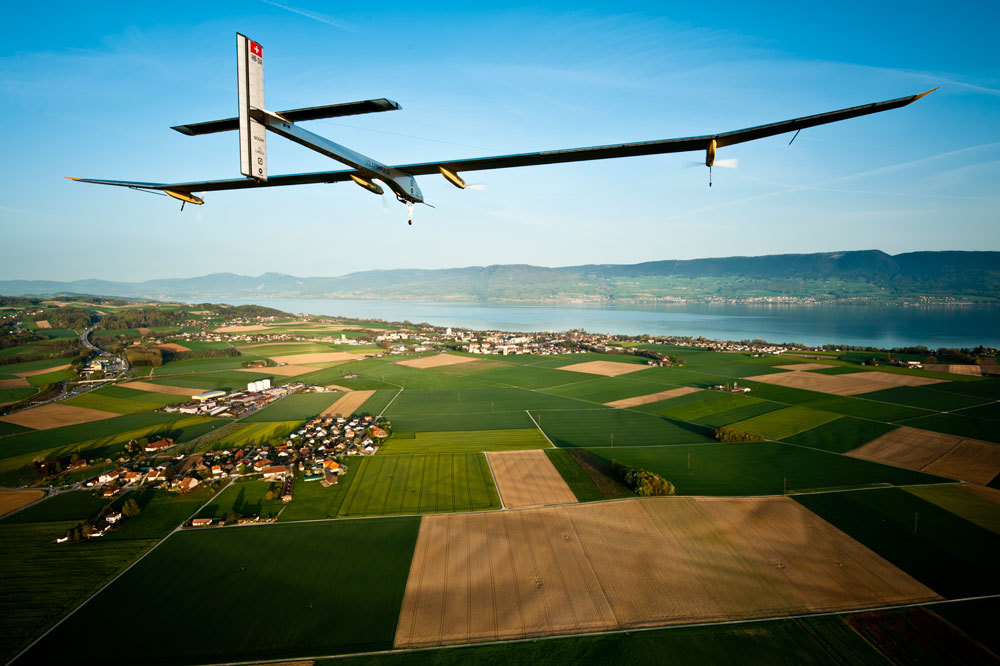
The project isn’t just a stunt. The glider-style airplane with a 36-meter (120-foot) wingspan will be a test of technologies that are set to be used to build new generations of autonomous craft for the military and business, say aerospace experts. They will fly continuously, have far greater reach and control than satellites and expand broadcast, communication and spying capabilities around the globe.
Previous attempts have used multiple flights. Switzerland’s Solar Impulse, with partners including Google, Dassault Aviation SA and ABB Ltd., made 17 stops to complete its globetrotting trip last year.
“Our flight should prove that it’s possible to make long-distance flights using solar energy,” said Mikhail Lifshitz, Renova’s director of high-tech asset development and a qualified pilot-instructor. A “flying laboratory” test-plane will be ready by year-end, Lifshitz said in an interview.
That gives his team two years before the record flight, which will be piloted by Fyodor Konyukhov, 65, an adventurer and ex-special forces soldier known in Russia for sailing around the globe multiple times, traveling to the North and South Poles and twice scaling Everest. In April, Vekselberg vowed to Russian President Vladimir Putin to get the job done.
Renova’s plane will use so-called supercapacitors, effectively extremely efficient batteries, to drive its propellers and store power generated from solar panels mounted on the top and underside of the craft. The panels will draw on both direct and diffuse light, allowing them to suck in energy straight from the sun and from rays reflected back up from the clouds.
At night, the airplane will conserve power by gliding down from high altitudes before climbing again when the sun is up.
“This particular proposal is very timely because the technology is there,” said David Baker, a 25-year veteran of NASA who now edits the British Interplanetary Society’s Spaceflight magazine. “It just needs the investment and money to put it all together.”
Zeal for aerospace is growing among investors like Richard Branson, with his Virgin Galactica Ltd., and fellow billionaire Elon Musk’s Space Exploration Technologies Corp. as scientific advances turn flights of fancy into commercial propositions. Branson is himself famous for well-publicized stunts including attempts to span the globe in a balloon.
Vekselberg, who became Russia’s fourth-richest man though oil and metals, has expanded into tech since selling out of crude in 2012, with investments including a joint venture solar maker and power producer. He’s invested in OC Oerlikon Corp., which is involved in making solar-equipment products. He’s also the president of the Skolkovo Foundation, which is overseeing the creation of a tech hub near Moscow.
Self-powered and unmanned craft that can stay airborne for long periods are of great interest for business, allowing mobile communications to go far beyond the reach of satellites at a lower cost, BIS’s Baker said.
“The military of course are interested in this for long-duration eavesdropping and telecommunications,” he said. “There’s a lot of Hollywood myth about what satellites can do. You can’t immediately grab a satellite and steer it in to focus down for about six days to listen in to potential terrorists.”
Spies Like Us
While Renova isn’t disclosing its investment in the flight, its Hevel Solar joint venture spent about 20 billion rubles ($355 million) on panel production, with an upgrade at the end of 2016 adding 3.8 billion rubles.
It has invested about $30 million in its Khimki supercapacitor plant to make an annual 200,000 cells used to store power for diverse purposes, Lifshitz said. It aims to expand to 6 million cells with a new plant.
The effort to send a pilot around the world by 2019 will provide a test bed for such technologies and a target to encourage further innovation, as well as developing enthusiasm from the public and potential investors.
“People are interested in things involving people,” Baker said. “If this was some weird gizmo that was unmanned, it wouldn’t quite attract the attention. It’s the Branson factor.”